CUBA
The music of Cuba, including the instruments and the dances, is influenced mostly by African, European (especially Spanish) and Chinese music. Most forms of the present day are fusions and mixtures of these sources, mainly the first two. Cuban music has been immensely influential in other countries. It contributed not only to the development of jazz and salsa, but also to the Argentine tango, Ghanaian high-life, West African Afrobeat, Dominican Bachata and Merengue, Colombian Cumbia, Spanish Nuevo flamenco and to various forms of pop music around the world.
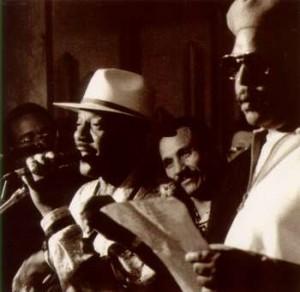
Music in Cuba
The Son cubano is a style of music that originated in Cuba and gained worldwide popularity in the 1930s. Son combines the structure and elements of Spanish canción and the Spanish guitar with African rhythms and percussion instruments of Bantu origin. Its’ derivatives and fusions, especially salsa, have spread across the world.
Son remains the basis of most popular forms of modern Cuban music. Son is represented by long-standing groups like , which was re-established in 1985, Orquesta Aragón, Orquesta Ritmo Oriental and Orquesta Original de Manzanillo. Sierra Maestra. Meanwhile, Irakere fused traditional Cuban music with jazz, and groups like NG La Banda, Orishas and Son 14 continued to add new elements to son, especially hip hop and funk, to form timba music.
Cubans have never been content to hear their music described as salsa, even though it is crystal clear that this was a label for their music. For the most part, timba equals salsa cubana, though there are claims that it is something more. Since the early 1990s timba has been used to describe popular dance music in Cuba, rivalled only lately by Reggaetón. Though derived from the same roots as salsa, timba has its own characteristics, and is intimately tied to the life and culture of Cuba, and especially Havana. http://www.youtube.com/watch?v=AF9KLJD-loc
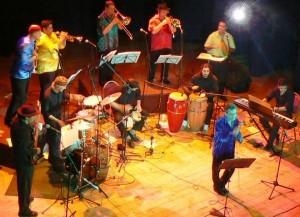
Salsa band
Rap/hip-hop
After the collapse of the Soviet Union, the Cuban economy went into decline. Poverty became more widespread and visible in Cuba. In the 1990s, some Cubans start to protest this situation by means of rap and hip-hop.
Government and hip-hop
The Government scheme gives rap and hip-hop groups time on mass media outlets in return for hip-hop artists limiting self expression and presenting the government in a positive way. The hip-hop artists talk about everyday life in Cuba. However, most critics believe that the Cuban Rap Agency will hide rappers’ opinions of the Cuban government.
Reggaeton/Cubatón
Reggaeton from Panama is a new genre for the Cubans but by 2012 was so massively popular that “the face of Cuban pop music” was considered to be Cuban reggaeton (cubatón) singer, Osmani García http://www.youtube.com/watch?v=tk-7korCNZQ (“La Voz”). Other popular cubatón artists include Eddy K and Gente de Zona (“People from the ‘Hood”).
Rockoson is a form made with elements of timba, nueva trova and rock and roll made since the late 1980s by groups like “Vanito y La Lucha Almada” and “Habana Abierta”. http://www.youtube.com/watch?v=-IlYJdpFwZw
MEXICO
There are many different styles of Mexican music and all of them are steeped in culture and traditions. Before the Spanish arrived in 1519, the area was dominated by the Aztec culture, a culture that maintained an important and complex musical tradition. Even after the Spanish arrival where Mexico was to remain under it’s domination for the following two hundred years, the Mexicans still incorporated their Pre-Columbian roots together with the lasting influence that came with the Spanish. The Spanish regime also imported African slaves, adding a further dimension to the progress of Mexican music through history. Numerous folk styles and classical music have come from this combination, and regional styles really reflect these traditions.
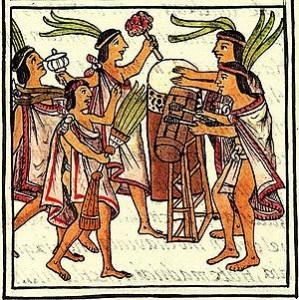
Aztec music
Mexican son first appeared in the 17th century and is a fusion of indigenous, Spanish and African traditions, much like Cuban son, and exhibits much variation from different regions, both in rhythm and instrumentation. Mariachi is probably the most well known son-style and is said to be in the very root of every Mexican’s heart http://www.youtube.com/watch?v=h9KQbbheFcM. After the Mexican Revolution in 1910, it was declared to be Mexico’s national music and throughout history has traditionally been played at weddings and other traditional Mexican functions. The usual mariachi group today consists of as many as eight violins, two trumpets and one or more guitars. Mariachi was recognized by UNESCO as part of the Intangible Cultural Heritage of Humanity in 2011.
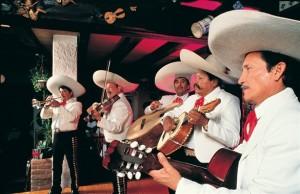
Mariachi band
After the introduction of Mariachi, it then further produced some of the styles like Ranchera which really gained momentum and was really popular in Latin America, especially after the Mexican Revolution. Norteño evolved with an intermingling of Mexican son, Czech and Bohemian rhythms. During the 19th century, Czech and Bohemian people brought some new music styles and musical instruments like the accordion. The newly introduced music style of those migrants amalgamated with the existing Norteño and started to be played by local bands. That was the start of the evolution and transformation of Norteño the impacts of which can still be seen as the accordion has now become one of the most integral parts of this music genre.
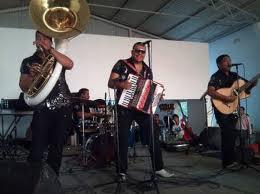
Norteño band
The Mexican rock movement began in the late 1950s and early 1960s. One of the early Mexican Rock bands came out of the predominantly Mexican barrio community of East Los Angeles, “Los Nómadas” (The Nomads). Mexican Rock combined the traditional instruments and stories of Mexico in its songs. Mexican and Latin American Rock en Español, remain very popular in Mexico.
Mexico also has a long tradition of classical music, as far back as the 16th century, when it was a Spanish colony.
COLOMBIA
The diversity in musical expressions found in Colombia can be seen as the result of a mixture of African, native Indigenous, European (especially Spanish) influences, as well as more modern American and Caribbean musical forms, Cuban, and Jamaica.
Colombian salsa
Salsa music was born among Puerto Ricans and Cubans, but soon spread to Colombia. Native salsa groups like Fruko Y Sus Tesos and labels that recorded them like Discos Fuentes emerged. Artists like Joe Arroyo followed, inventing a distinctively Colombian form of salsa. Other influential Colombian salsa bands include Cristian Del Real ”The Timbal Genius”, Grupo Niche,Alquimia, La Misma Gente, Los Titanes, Los Nemus del Pacífico, Orquesta Guayacán and Grupo Galé. http://www.youtube.com/watch?v=5-0UI9Ify3I
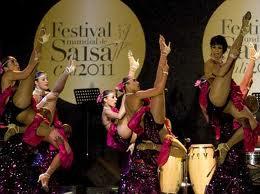
Colombian salsa
Colombian rock music
In the late 1950s, Mexican rock artists like Enrique Guzmán and César Costa became very popular in Colombia. Soon, native rock bands like Los Speakers and The Flippers gained a wide following.
Rock in Colombia gained great popularity during the 1980s with the arrival of bands such as Soda Stereo (Argentina), Los Prisioneros (Chile), and Hombres G (Spain). During the 90′s, many punk and heavy metal bands appeared in Bogotá, Medellín, and Cali. Colombia has possibly the biggest underground, hardcore, metal and punk movement of the continent, and is known in Latin America as the “punk corner”. Aterciopelados, Kraken and Masacre are some of the most important Colombian rock bands.
But, possibly, the most successful “indie” band is Sidestepper, with its fusion of Colombian traditional music, electronic and African rhythms, who already appeared in Coachella Festival in 2006. http://www.youtube.com/watch?v=Ns_HUjOWBo4

Sidestepper
Colombian pop music
Shakira is the highest selling and most recognized Colombian artist. After the success of her album Pies Descalzos in 1995, Shakira began working with producer Emilio Estefan Jr. and recorded ¿Dónde Están los Ladrones? which sold millions world wide. http://www.youtube.com/watch?v=D4vThayCqfQ

Shakira
Other artists include:
Globe.
-
Maía,
-
Paula Arenas
Colombian urban and hip-hop music
Hip Hop came to Colombia in the late 1980s when a few US Hip-Hop tracks by NWA and MC Hammer spurred a break-dancing fever among the young of the less privileged areas of major cities such as Medellín, Cali and Bogotá. Towards the end of this decade groups began to form, eventually leading to complete album productions in the mid-1990s.
Reggaeton took hold in the 1990’s while hip hop took a back seat for a while. Reggae has always been popular in the Colombian Caribbean Islands.
2006 brings a renaissance in Colombian Hip-Hop in the form of Afro-Colombian group ChocQuibTown, fusing traditional rhythms and instruments from their native lands in the Colombian Pacific into their sound. Already hailed as the new phenomenon in Colombian Hip-Hop, their popularity is ever increasing and making way for other Urban artists to emerge. http://www.youtube.com/watch?v=zymwAUmhCp4&noredirect=1
ECUADOR, PERU, BOLIVIA AND CHILE
The haunting but magical sounds of pan pipes have formed a part of the Andean landscape for over two millennia. Andean music comes from the broad area in which the Inca Empire expanded over centuries including Bolivia, Ecuador, Chile, Peru and even parts of Argentina, Colombia and Venezuela. These days, bands made up of traditional pipes and string instruments can be found easily in these places.
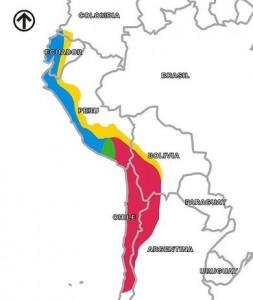
The extension of the Inca Empire over centuries
Originally from the Cuzco Valley, the Incas expanded rapidly and in little more than two centuries, they stretched as far north as southern Colombia, and as far south as the Rio Maule in southern Chile.
While the Incas certainly employed the instruments we know as “Andean”, it is important to understand that many cultures preceded the Inca dynasty. Some include the huge Aymaran population in Bolivia, the Nazcan populations of Peru and others such as the Moche, the Huari, Chimú and Chavín, all of which had already developed many musical styles and instruments that the Incas merely adopted later on.
Throughout these dynasties, music was a sacred art and a powerful source of communication with the divine world. It is important to note that prior to the arrival of Europeans, there were no string instruments in South America. The Andes were dominated by the sound of wind and percussion. Some percussion instruments include the wancara, bombo and chajchas and wind instruments that were utilized include the siku, antara, carina and the quena which has actually been proven to be around before the birth of Christ.

The quena
Upon European arrival, natives were introduced to new, exotic instruments like the lute, guitar, harp, violin and accordion and later they would be introduced to brass instruments including saxophones, trumpets and tubas. Another pinnacle change to the Andean musical world was the introduction of western musical scales: major and minor keys, sharps and flats.
Andean music is not restricted to traditional sounds; African rhythms from the coast and salsa joined to create a musical melting pot. Over the centuries these styles gradually blended together and what can be heard today is literally a result of centuries of colonialism and the migrations of peoples from different regions and continents.
The pipes of ancient South America continue to be used by native populations, and their popularity shows no signs of disappearing. http://www.youtube.com/watch?v=pey29CLID3I
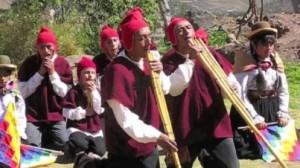
Pipe band
Of course, rock is very popular as well throughout this very huge region and is often heard in the numerous bars and clubs which attract the youth.
BRAZIL
The music of Brazil comprises of numerous regional music styles influenced by African, European and Amerindian forms. Throughout history, Brazil has developed some very unique and original styles that are well-known world over.
A great example of this is samba especially as it is the popular music backdrop for Brazil’s annual Carnaval celebrations. Samba usually utilizes instruments like cuicas, tambourines, frying pans (‘played’ with a metal stick), flutes and guitars and artists including Paulinho da Viola, Beth Carvalho and Alcione are among the most influential sambistas.

Samba school performance, Rio Carnaval
Bossa Nova is another well-known style, especially because of the song ¨The Girl from Ipanema¨that became famous in the mid-1960s http://www.youtube.com/watch?v=c5QfXjsoNe4. In terms of harmonic structure, bossa nova has a great deal in common with jazz and samba also, although samba but is more complex harmonically and as opposed to Samba’s origins in the favelas, bossa nova emerged primarily from the upscale beachside neighborhoods of Rio de Janeiro.
Other popular styles in Brazil today include lambada, zouk, choro, frevo, forró, maracatu, MPB, funk carioca, RAP, sertanejo, Brazilian rock, pagode, tropicalia, axé, brega, and there is also a growing community of modern/experimental composition, including electroacoustic music.
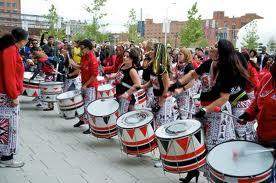
Drum band
There is also still a huge presence of indigenous music in the country. Much of Brazil’s native music imitates the sounds of the Amazon Rainforest and instruments including whistles, flutes, horns, drums and rattles are used to create these sounds and that type of atmosphere.
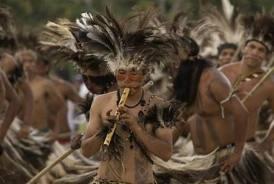
Native music
